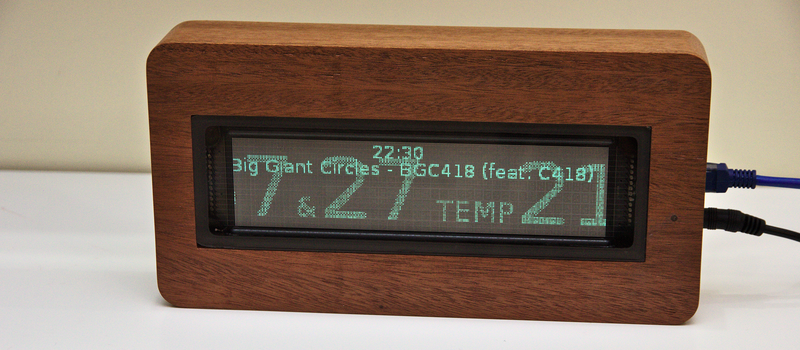[Sprite_tm] picked up some used VFD displays for cheap, and wanted to make his own custom temperature and air-quality display. He did that, of course, but turned it into a colossal experiment in re-design to boot. What started out as a $6 used VFD becomes priceless with the addition of hours of high-powered hacking mojo.
You see, the phosphor screen had burnt-in spots where the old display was left static for too long. A normal person would either live with it or buy new displays. [Sprite_tm] ripped off the old display driver and drives the row and column shift registers using the DMA module on a Raspberry Pi2, coding up his own fast PWM/BCM hybrid scheme that can do greyscale.
He mapped out the individual pixels using a camera and post processing in The Gimp to establish the degradation of burnt-in pixels. He then re-wrote a previous custom driver project to compensate for the pixels’ inherent brightness in firmware. After all that work, he wrapped the whole thing up in a nice wooden frame.
There’s a lot to read, so just go hit up his website. High points include the shift-register-based driver transplant, the bit-angle modulation that was needed to get the necessary bit-depth for the grayscale, and the PHP script that does the photograph-based brightness correction.
Picking a favorite [Sprite_tm] hack is like picking a favorite ice-cream flavor: they’re all good. But his investigation into hard-drive controller chips still makes our head spin just a little bit. If you missed his talks about the Tamagotchi Singularity from the Hackaday SuperCon make sure you drop what you’re doing and watch it now.
















am I the only one how came here for the Varible Frequency Drives (VFD)? hahahaha
Nope, i was also hoping to see a motor driver project.
You might be a hacker if you saw “VFD” with an image of a Vacuum Fluorescent Display and thought about some AC motor drive.
– Jeff Fluxworthy
hahaha I’m actually from the AC Drives industry, so this was the first thing that came into my mind when I READ the news title
Did you not see the picture?
I thought it was the screen for the Variable Frequency Drive, didn’t know that the Vacuum Fluorescent Display “existed”, sure I had seen them, but didn’t know how they were called. Well, now I know =D.
BTW, didn’t read what was in the screen. If I would have read it, the name of the song wouldn’t have make sense haha.
Yes I saw a wood box and a green display, but that could well be the HMI of the VFD Drive
Brilliant hack!
I think most of us would have either tossed the VFDs or lived with the burn-in. Heck, I would have given up completely, but I suck at that sort of thing.
Well done as always, [Sprite_TM].
Wow. That’s a LOT of work. I rate that a “Damn, son!” Maybe Noritake would like to hire him.
I’d have just found a IPS LCD and faked it.
I’m going to be disappointed if you did not calculate a gain and offset for every pixel :-)
[Sprite_TM] deserves an upgrade to [Sprite_R] :-)
Props for choosing Big Giant Circles on the playlist!
Nice, now get back to work on esp32! ????
Utterly, utterly bonkers. In a good way.
This is so cool! Great Job! Wish some of the CNC’s at work could do this to the 20 years of burnt-in CRTs. Maybe if I put a magnet to deflect it just a little bit…